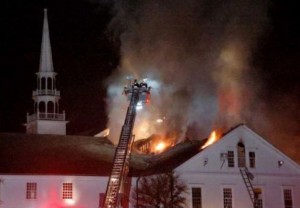Living History
The life of The Saugatuck Congregational Church, which covers a span of more than 180 years, reveals a story of a community of faith which seeks to give God glory.
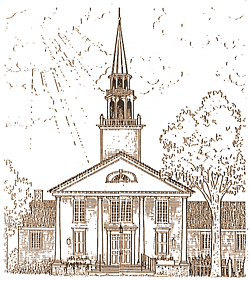 It began in 1830 when our village, named Saugatuck (meaning “mouth of the tidal river”) was still a part of Fairfield, Norwalk, and Weston – the towns from which Westport would be carved in 1835. Saugatuck was a busy, flourishing community; a shipping port for the produce from surrounding farms, which was carried by onion boats to Boston and New York. It was a stagecoach stop on the important Post Road.
It began in 1830 when our village, named Saugatuck (meaning “mouth of the tidal river”) was still a part of Fairfield, Norwalk, and Weston – the towns from which Westport would be carved in 1835. Saugatuck was a busy, flourishing community; a shipping port for the produce from surrounding farms, which was carried by onion boats to Boston and New York. It was a stagecoach stop on the important Post Road.
Among the prominent families at the time was that of Ebenezer Jesup. He was a dealer in grain and produce, shipping mostly to Boston, and he soon became the wealthiest resident of the village.
Although Jesup lived in Green’s Farms, his wharf and warehouses were along the river, and in 1810 he decided to build a home more convenient to his place of business. Jesup’s home was considered the finest mansion in Fairfield County, and that location eventually became the center of town.
As the community grew, there arose an interest in organizing a local church and ecclesiastical society. Their meetinghouse in Greens Farm’s was only three miles away, but travel was difficult and attendance at worship in those days was required.
This was no small decision for these men and their families. The church played an important role in their social life, and one can well imagine the difficulties caused by such an upheaval, despite the fact that they were moving only a short distance.
The Saugatuck Meetinghouse Association was formed in 1830 to plan for the building of a meeting house in the area known at that time by “the significant and euphonious name of Saugatuck.” The committee consisted of Samuel Avery, Ebenezer Jesup, Sullivan Moulton, Thomas F. Rowland, the Honorable Samuel B. Sherwood, and Dan Taylor.
Keeping with honored custom, they chose a lofty and commanding site on the south side of the Post Road, about 600 feet east of the present church.
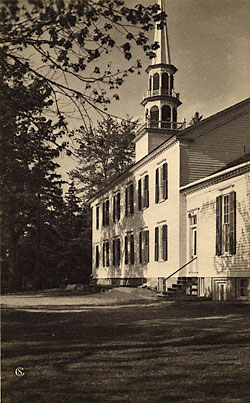 The new Saugatuck Meetinghouse was to be at least as spacious and attractive as the one they were leaving in Green’s Farms. The specifications were most carefully and minutely drawn by the lawyer Samuel Sherwood; no details were overlooked. We see evidence throughout the contract of the clear, shrewd business mind of Squire Sherwood, and the great care that everything in the new structure should be of the best material and finished after the most approving style.
The new Saugatuck Meetinghouse was to be at least as spacious and attractive as the one they were leaving in Green’s Farms. The specifications were most carefully and minutely drawn by the lawyer Samuel Sherwood; no details were overlooked. We see evidence throughout the contract of the clear, shrewd business mind of Squire Sherwood, and the great care that everything in the new structure should be of the best material and finished after the most approving style.
Formally trained architects were still rare in the States and virtually unknown in rural areas. Builders of early 19th century churches would, in all likelihood, have seen pattern books and would borrow extensively from similar churches in nearby towns. It is also likely that they were familiar with architectural developments in England at the time. The austere, totally functional design favored by Puritans was being diluted by growing prosperity and a more comfortable lifestyle; ornamentation and beauty were desirable.
Uriah Ambler was the contractor for the Saugatuck Meetinghouse project. His contract of $2,500 was paid in July 1832, along with $65.25 allowed for “extra bills” and $63.51 paid to Thomas Rowland for underpinning stone. Financial records from March through September 1832 for “one quart of rum $.22, one quarter of brandy $.13, three barrels of beer $9.30, and another quart of rum per verbal order from Captain Avery,” indicated the workers were well cared for.
Whatever the credentials and experiences of these men, their efforts for the Ecclesiastical Society were well received and have stood to their credit until the present day.
Building funds were partly obtained by subscription; the balance was received by settlement with the Green’s Farms Society.
New Meetinghouse
The new meetinghouse was completed and dedicated, and The Saugatuck Congregational Church was organized on June 5, 1832.
The original members numbered 36 and were, at their request, dismissed by letter from the Green’s Farms Congregational Church.
The Society, instituted for the support of the new church, pledged maintenance of public worship, “agreeable to the form and all principles of the Presbyterian or Congregational Churches of the United States.” Among other items of business at this first meeting of the Society, it was voted “that the place for setting up notices for future meetings of the Society be on the oak near the northwest corner of the new meetinghouse.”
Matters of Church and State
In February 1833, The Rev. Charles A. Boardman became Saugatuck’s first pastor.
The Town of Westport was incorporated on May 28, 1835. Three weeks after that, on June 16, 1835, the first town meeting was held at Saugatuck Congregational Church. (The first town budget, presented later that year, was $608.42.)
The young church raised money by auctioning the “slips” (pews) for six months’ rental. Rentals falling in arrears prompted a vote, “that the slips in the meetinghouse hereafter be rented for cash, to be paid down before the meeting dissolved.” The pews in the church today are still the original ones, although at one time they were equipped with doors.
Sabbath School and First Expansion
The Sabbath School was organized in the summer of 1832. Classes met in the balcony and sanctuary, and a drum and fiddle assembled the children. In 1866, a social hall and church school extension were built at the rear of the sanctuary. Funds were raised for this project by ladies’ fairs, festivals, lectures, and a concert of eminent artists. This facility served the congregation until the meetinghouse was moved in 1950, when it was sold to the Westport Woman’s Club.
Evergreen Cemetery
In March of 1836, the Society of Saugatuck purchased the present church cemetery, consisting of one acre, for $302.50. In 1963, the Gorham family deeded .36 acres on the North that had been the private Gorham family cemetery.
Expansion and Renovation
A sense of stewardship and sharing has guided the missionary program from an early date. In 1852, one Sabbath every fourth month was designated for the collection of money to be sent to domestic and foreign missions.
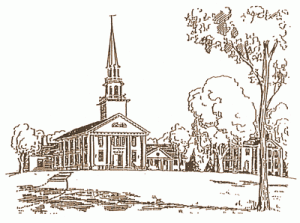 As the church grew, it was decided it was necessary “to enlarge this meetinghouse by carrying the pulpit back 13 feet.” Architectural evidence shows this addition in 1857 was the full width of the building.
As the church grew, it was decided it was necessary “to enlarge this meetinghouse by carrying the pulpit back 13 feet.” Architectural evidence shows this addition in 1857 was the full width of the building.
Music was provided by a bass violin and later a hand-pumped organ until1892, when a pipe organ operated by water was installed. This organ was later adapted to electric power and served until 1960 when a 3-manual Austin pipe organ was donated by Gertrude Hotchkiss Heyn in memory of her mother. When the organ was installed, the choir loft and arch were somewhat redesigned.
In 1924, the interior of the meetinghouse was redecorated. The carpets were removed and replaced with runners, some ornamental plastering was removed and the seats, formerly stained, were painted white.
The restoration committee tried to replicate the interior of the sanctuary as it might have appeared earlier. The red/green ingrained carpeting, the red damask seat cushions, and the red pulpit curtain were quite common, according to historical research. “The decorative embellishments of the early and middle years of the 19th century were often swept away, together with the earlier decorative treatments” in favor of what was believed to be a sparse “early look.”
New Land – New Parsonage
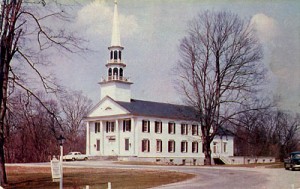 In 1884, Morris K. Jesup gave the church the house and about eight acres of land which had been the home of his grandfather, Ebenezer Jesup. The gift was by conditional deed which provided that “the property was to be used as the parsonage and as a future site for the meetinghouse, should it be moved there or a new one built. The land could never be sold or used as security for a loan.” It did become the parsonage, which is known as “Jesup House.”
In 1884, Morris K. Jesup gave the church the house and about eight acres of land which had been the home of his grandfather, Ebenezer Jesup. The gift was by conditional deed which provided that “the property was to be used as the parsonage and as a future site for the meetinghouse, should it be moved there or a new one built. The land could never be sold or used as security for a loan.” It did become the parsonage, which is known as “Jesup House.”
Jesup House was constructed sometime between 1807 and 1810. Once considered the finest house in Fairfield County, it is a fine example of the post-Revolutionary Period, and is often sketched, studied and written about by architectural scholars.
For 100 years, the church followed the fortunes of the community with a slow and steady growth in membership, practically parallel to the growth of the population.
A New Pastor
The Reverend Mr. Gibson Daniels of Hartford, State Director of Religious Education, accepted the call of the church as Minister in October 1943. This began the longest period of ministry in the history of Saugatuck.
Church Building Moved
When Westport began its rapid expansion in the 1940s, the church’s increased membership meant more space was needed. After careful study by a building committee, a resolution was passed at a congregational meeting in 1947, authorizing the move of the meeting house from where it had stood for 115 years to the Jesup property on the other side of the Post Road. Perhaps the original idea came from Morris Jesup’s 1884 letter donating the parsonage property to the church, suggesting and anticipating such a move by more than 60 years.
In the early dawn of August 28, 1950, the Post Road was blocked, and 500 men, women and children gathered before the meetinghouse for a brief service of prayer and thanksgiving. They sang two verses of “Faith of Our Fathers” accompanied by a portable organ, and witnessed an official tape-cutting ceremony. Then at the speed of 60 feet per hour, the 200-ton building was moved down a 19-foot incline on 55 logs, which revolved under runners. After a journey lasting 10 hours, the meeting house stood adjacent to the parsonage across the Post Road. Here is how the move was reported in the September 11, 1950 issue of Life Magazine:
…Sightseers came from all over fashionable Fairfield County to watch, and church members sold food to help pay the $10,000 moving bill. Said one Westport matron, “This is more fun than a cocktail party!”
New Addition
In 1954 an ambitious building program began, to meet the need for church school classrooms, special rooms for church functions, and office space. The entire project was completed in October 1956 and immediately work began to establish a memorial garden, which is still cared for by members of the congregation.
Church Union
In 1961, by a vote of 255 to 11, the congregation voted to join in the fellowship of The United Church of Christ, which had been formed in 1957.
Saugatuck Nursery School
In 1968, Saugatuck Nursery School was founded based on the inspiration of Dr. Martin Luther King Jr.’s vision of racial peace. While non-denominational in nature and not formally aligned with our church, it nonetheless became a sister organization to our own. We are inspired by their nurturing, professional teachers and the warm and caring environment.
Equality
After extended discussion, in a special meeting on September 8, 1968, the Congregation voted to approve the proposition that the Deacons would be elected “… without regard to sex.” One male member who opposed the action stated that he felt “the presence of women would be a distraction.”
The Daniels Era Ends
After 28 years of dedicated service, the Reverend Mr. Gibson Daniels, D.D., submitted his resignation in May 1971 so that he might respond to a call from the First Congregational Church of Woodstock, Connecticut. The Reverend Mr. Theodore Hoskins was called in June to be the 18th Senior Minister of Saugatuck.
Mission
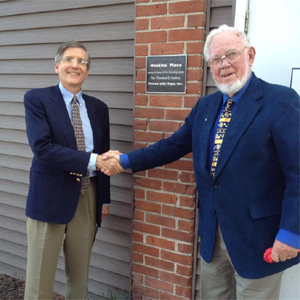 In 1984, the Interfaith Housing Association was chartered by the State of Connecticut following five years of effort by Westport and Weston religious leaders, led by Ted Hoskins. The Gillespie Center is named in honor of James Gillespie, one of the original supporters of IHA and a member of Saugatuck.
In 1984, the Interfaith Housing Association was chartered by the State of Connecticut following five years of effort by Westport and Weston religious leaders, led by Ted Hoskins. The Gillespie Center is named in honor of James Gillespie, one of the original supporters of IHA and a member of Saugatuck.
Prior to the establishment of the IHA, a number of the homeless slept in the Saugatuck Meeting House. At the May annual meeting, Ted Hoskins noted,
“The church does not exist to serve itself,
but to serve God as we know him in Jesus Christ.”
Long-range Plan
A long-range plan was completed, and the strengths of Saugatuck noted in the report were:
Dynamic Worship Relational Groups
Dedication to Mission Excellent Functional Characteristics
Strong Leadership
Major Restoration: 1990-1993
In April 1990, a three-year program for the restoration of the meetinghouse and parsonage was approved by the congregation. Members and friends of the church responded enthusiastically, and just over $1 million was committed to the project.
Work began in February 1991 under the leadership of George Mangold. The steeple was removed and repaired, and the meetinghouse, church school addition, and Jesup House were completely restored. Hoskins Hall was given a complete facelift, storage space was constructed, and an elevator was installed to provide handicapped access from the ground level to the sanctuary, meeting rooms and Hoskins Hall. The entire project was completed by November 1993, and a week-long celebration was held. In his letter of dedication, Ted Hoskins wrote:
“Now, suddenly, as we have shared in this major program of restoration and renewal, we discovered that we join the ranks of those whose energy and imagination built this Meeting House so long ago. Now, we are one with those whose foresight and courage brought this steepled place of worship across the Post Road. Now, we stand with those whose commitment and dedication added so much room for education and service.”
New Pastors
In the fall of 1993, The Reverend Mr. Hoskins resigned after 22 years as Senior Minister and seven years as Associate Minister. His leadership caused Saugatuck to be recognized as a congregation that served families and individuals in the many appropriate ways of acting out the meaning of God’s Word in our midst. Among his many accomplishments was the establishment of Thanksgiving and Christmas Feasts, open to everyone in the community.
In 1995, the congregation called a married couple, the Reverend Ms. Martha (“Martie”) McMane and the Reverend Mr. Alan Johnson, to be co-pastors of Saugatuck. They brought high energy and enthusiasm to their role in the life of the church, including organizing the “Dine with Nine” dinners, initiating the Small Group Ministries, relocated two families and four young men from Kosovo, and instituting the passing of the peace during the worship service. Martie responded to a call to be the Senior Pastor for a UCC church in Boulder, Colorado in 1998.
A New Millennium, New Leadership and New Challenges
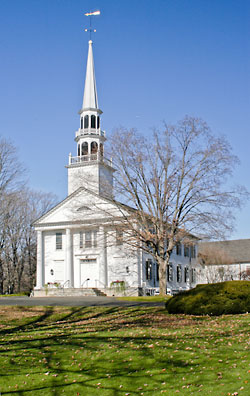 On September 10, 2001, the Reverend Dr. John Danner responded to the call of the Holy Spirit and became Saugatuck’s Senior Pastor. He was Pastor for less than 24 hours before having to help the entire Westport community deal with the horrific terrorist attacks of September 11th.
On September 10, 2001, the Reverend Dr. John Danner responded to the call of the Holy Spirit and became Saugatuck’s Senior Pastor. He was Pastor for less than 24 hours before having to help the entire Westport community deal with the horrific terrorist attacks of September 11th.
During his tenure, the church cemented its reputation as a true “community church,” opening its doors to the needs of many people, including more than 50 different 12-Step Groups, a Boy Scout Troop, The Y’s Men, and various other community groups. He also served as President of the Westport-Weston Clergy Association.
Our Community Feasts, held annually each Thanksgiving and Christmas Day, attract hundreds of people from all over the area for a delicious turkey dinner, live music, and warm fellowship.
Vision Statement
In 2003, a Visioning Team completed their work and the congregation voted to adopt their recommended Vision Statement as representing who the congregants of Saugatuck are, and what they are about:
A Community of Christ
Welcoming All People
Learning to Love and Serve
God and Neighbor
Open and Affirming – “ONA”
Following three years of intensive study and dialogue, the congregation followed the recommendation of the Inclusiveness Ministry Team by voting at its annual meeting in February 2007 to adopt in its bylaws this statement:
We welcome anyone who seeks God into the fellowship, worship and work of this church without regard to their race, ancestry, age, physical or mental ability, gender, sexual orientation, social and economic status or religious background.
By adopting this statement, Saugatuck became recognized by the United Church of Christ as “Open and Affirming.”
Destruction
At 9:50 PM on Sunday, November 21, 2011, a devastating fire broke out in our cherished church home. When Westport Fire Chief Andrew Kingsbury pulled up and saw the smoke pouring out of the windows, he said later, “I thought for sure it was going to burn to the ground.” For six grueling hours Westport firefighters, assisted by units from five other communities, battled a smoky inferno.
To prevent the fire from spreading to the sanctuary, Westport ladder truck 1, joined by Norwalk truck 2, attacked the blaze on the exterior. Another ladder company from Fairfield was called to help protect the sanctuary and steeple, as well as two engines from Norwalk, a hose wagon from Weston, a fourth ladder tower from Wilton, and a mobile air truck from Trumbull.
The fire was not brought under control until 3:47 the following morning, and no part of our church was left untouched by some degree of fire, smoke or water damage. But miraculously, our 181-year-old sanctuary – while suffering massive smoke and water damage – was spared the most severe ravages of the fire, and our iconic steeple still stood tall over the town of Westport.
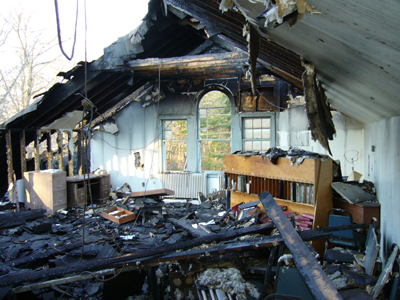 But inside, we had suffered a devastating loss. The rear of the building where the choir loft, meeting rooms and Saugatuck Nursery School were located suffered the worst damage. The roof above the choir loft and the Fellowship Room had collapsed and only the charred brick chimney remained standing. The extensive damage from the inferno and the massive amount of water used to extinguish the blaze destroyed our fine Austin organ.
But inside, we had suffered a devastating loss. The rear of the building where the choir loft, meeting rooms and Saugatuck Nursery School were located suffered the worst damage. The roof above the choir loft and the Fellowship Room had collapsed and only the charred brick chimney remained standing. The extensive damage from the inferno and the massive amount of water used to extinguish the blaze destroyed our fine Austin organ.
The following evening, with the smell of smoke still thick in the air, our front lawn became the site for a community gathering as congregants, friends, and neighboring clergy celebrated an interdenominational service. The outpouring of support from the community for Saugatuck was extraordinary.
The fire stirred the hearts of the congregation to coalesce and keep Saugatuck moving forward, and they scrambled to ensure that the work of the church could proceed. The Thanksgiving Feast – set to occur only four days after the fire – was moved to Christ & Holy Trinity Church. Donors lined up to replace what was lost in the fire (including the 30 Thanksgiving turkeys); Boy Scout and Girl Scout troops spent hours scrubbing pots retrieved from the ashes so they would be clean and usable.
Temple Israel opened their doors for our Sunday services, and became our primary worship space for the three years it took to rebuild our church. Temporary office space was secured. Efforts began immediately to assess the full damage and to begin remediation and cleaning of the church. A Building Committee was established, and Paul Bailey Architects were hired to craft a plan to re-vision and re-build Saugatuck Church.
New Beginnings: A Call
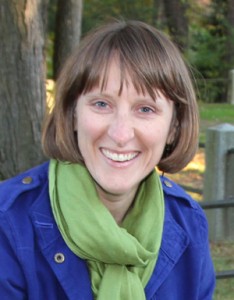 On Sunday, January 22, 2012, Reverend Alison J. Buttrick Patton was called as our pastor, unanimously and joyfully approved by the members who attended the Congregational meeting following the worship service. Energetic in her ministry, she is passionate about missions and social justice, and we are grateful for her gifts of mind, heart and spirit. She celebrated her first service at Temple Israel on May 6th, and was formally installed on October 28, 2012 at the Green’s Farms Congregational Church.
On Sunday, January 22, 2012, Reverend Alison J. Buttrick Patton was called as our pastor, unanimously and joyfully approved by the members who attended the Congregational meeting following the worship service. Energetic in her ministry, she is passionate about missions and social justice, and we are grateful for her gifts of mind, heart and spirit. She celebrated her first service at Temple Israel on May 6th, and was formally installed on October 28, 2012 at the Green’s Farms Congregational Church.
In addition, the congregation welcomed her family: her husband Craig and sons Tobey and Ian. Having young children in the parsonage has infused the grounds – even when the Meeting House was empty – with life, and the church’s sweeping lawn has been greatly improved by the addition of soccer games and snowmen.
Saugatuck as a “Church Without Walls”
Despite the lack of a meeting house, our church continued its work within Westport and the larger community – what Pastor Alison referred to as our time as a “Church Without Walls.” Hundreds of people enjoyed Thanksgiving and Christmas Feasts; our high school youth group continued to help in the wider community through their annual mission trips; hundreds of Christmas gifts were given out through our Angel Tree; clothing drives held; letters written to our Congressional delegation on behalf of SNAP benefit recipients; flags were planted on the great lawn of our church in prayerful remembrance of kidnapped Nigerian girls; and many, many other activities. Throughout it all we deepened our ties to the community and created new partnerships that will continue to grow and flourish for many years in the future.
Renewal
On June 17, 2012, architects Paul Bailey and Jarrett Crooks presented their initial concepts at a congregational meeting, and were enthusiastically received. This began an intensive 2½ year effort of rebuilding and restoration that not only returned our church to its former beauty, but added many modern features, expanding our ability to better serve both our congregation and the wider community.
Among the many improvements were the addition of central air conditioning throughout the entire church complex; a special entrance dedicated to Saugatuck Nursery School; a new and expanded Welcome Center; a commercial kitchen; and opening up Hoskins Hall with the addition of French doors leading to a stone terrace and stairs linking it to the Memorial Garden. We are profoundly grateful for the hard work and dedication of everyone on the Building Committee, and in particular the wise and steady leadership of John Walsh.
For generations, on both sides of the Post Road, Saugatuck Congregational Church has provided not only a place of meeting for the Christian worship of God and for instructions in faith, but also for an exchange of ideas and to help meet the challenges of society.
In 2014, we rejoiced in celebrating 182 years of worship as Saugatuck Congregational Church. A story, with God’s help, both treasured and continued. Our hope and our vision is to be:
A Community of Christ
Welcoming All People
Learning to Love and Serve
God and Neighbor
The steeple of The Saugatuck Church continues to stand tall, beckoning all who wish to share in this work to come through its open doors and to serve in the world.
“The glory of the Lord, filled the Lord’s house… and they worshipped and gave thanks to the Lord.”
2 Chronicles 7


